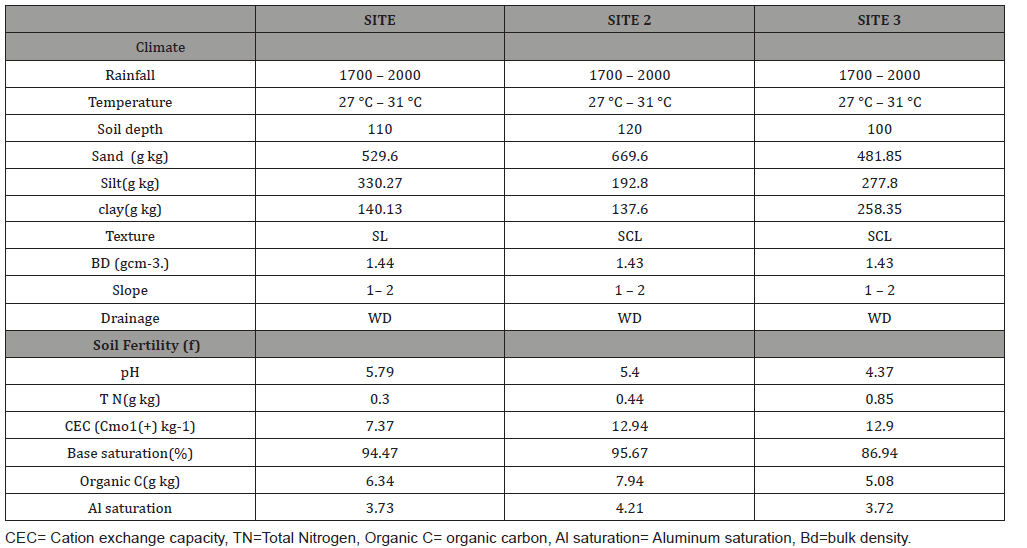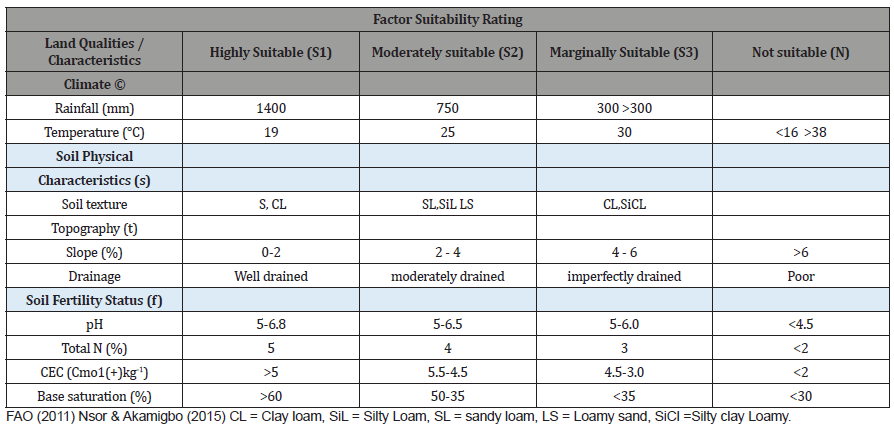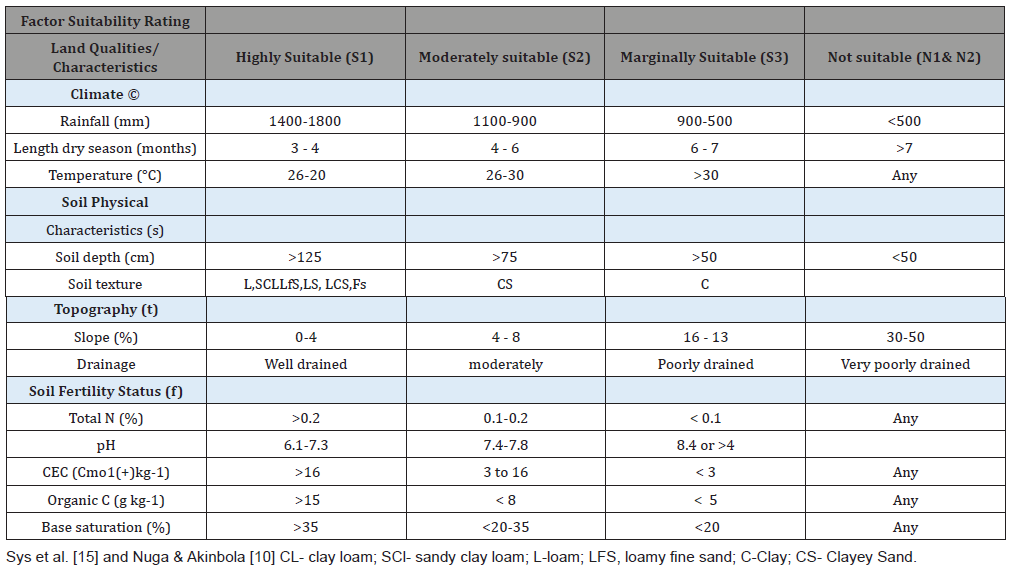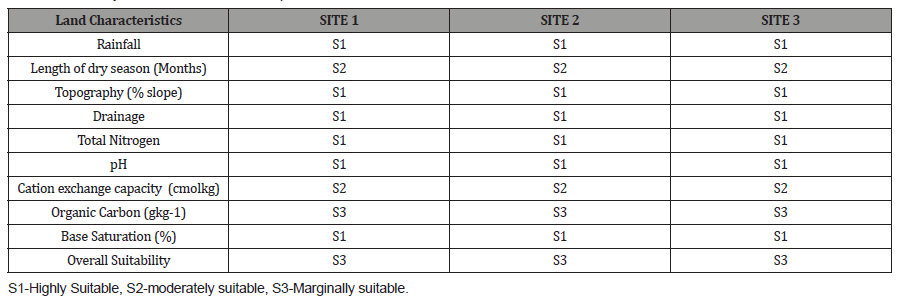 Research Article
Research Article
Suitability Evaluation of Urban Soils underline by Asu River Parent Material forCassava Manihotesculenta and Bambara groundnut (Vignasubterranea (L.) Verdc) Production in Ebonyi, Southeastern Nigeria
Chris-Emenyonu*, Onweremadu EU, Njoku JD and Ahukaemere CM
Department of Soil Science and Technology, Federal University of Technology, Nigeria
Chris-Emenyonu, Department of Soil Science and Technology, Federal University of Technology, Nigeria.
Received Date: April 27, 2020; Published Date: May 11, 2020
Abstract
Cassava and Bambara groundnut are commonly consumed crops in Nigeria. Cassava is a tuber crop of utmost importance in Nigeria and increasing the production of cassava will enhance food security because cassava is consumed widely in Nigeria and Bambara groundnut is the third most important legume after groundnut (Arachishypogaea) and cowpea (Vignaunguiculata) in Africa. Soil suitability evaluation of some urban soils derived from Asu river group in Ebonyi rainforest agroecological zone of South eastern Nigeria was undertaken to define the fitness of the soil for production of River for Cassava (Manihotesculenta and Bambara groundnut (Vignasubterranea (L.) Verdc). The FAO guideline for land evaluation was used. Results obtained showed that sand content ranged from 481.85 – 669.6 g kg-1, silt content ranged from 192.8 – 330.27 g kg-1 while clay content ranged from 137.6-258.35 g kg-1. Bulk density ranged from 1.43- 1.44 gcm-3 and textural class ranged from sandyloam to sandy clay loam. PH varied from very strongly acidic (4.37) to moderately acidic (5.79). Organic matter ranged from 5.08-7.94 g kg-1. Soils were low in available phosphorus with values ranging from 7.60-10.34 g kg-1 and total nitrogen ranged from 0.30 to 0.85 g kg-1. Suitability evaluation showed that all the sites studied were currently not suitable (N1) for cassava production when the pH requirement for cassava was matched with pH of the study area. These urban soils were also currently not suitable (N1) for Bambara groundnut production due to limitation of rainfall and total nitrogen. Therefore, this study recommends liming of soil of the study area to encourage cultivation and promote sustainable cassava production and in the cassava of bambara groundnut, since rainfall of the area is not suitable for its production, there is no need to embark on its cultivation except in alternative irrigation pattern is to be used.
Keywords: Urban soil; Cassava; Suitability Evaluation; Food security; Nigeria
Introduction
Nigeria is the most populous black nation in the World and in sub Saharan Africa [1]. Nigeria’s population 202,363,773 million [2], which is 61% of the World’s Population. 51.2 % of this population lives in urban area. Increase in population, especially in urban area means more persons to be fed and yet less available food in these areas due to insufficient food production as a result of unplanned land uses resulting to land degradation of urban landscape, Inadequate information on soil suitability prior to land use and lastly, Inadequate Information on urban and peri-urban soils for crop cultivation. Land suitability evaluation is used to ascertain the compatibility of the land for a specific type of use [3].
Cassava deserves special recognition as a crop which has placed food on the table of various homes in Nigeria and Africa as a whole. Nigeria is among the major cassava growing countries of the World and cassava is relatively adaptable to marginal soils and erratic rainfall. According to Anikwe, et al. [4], famine rarely occurs in regions where cassava is widely grown since it is known to provide a stable base to the food production system. According to Ahukaemere, et al. [5] cassava is primarily grown for its starch containing the tuberous root. These roots are the major source of dietary energy for more than 500 million people in African [6,7]. Cassava is a major crop in South Eastern Nigeria and can help in the quest for food security for the teeming population.
Bambara groundnut is the third most important legume after groundnut (Arachishypogaea) and cowpea (Vignaunguiculata) in Africa. Azam- Ali, et al, [8] reported that Bambara groundnut seed makes a balance food due to the fact that it contains sufficient quantities of carbohydrate (63%), protein (16.25%) and fats (6.3%) with relatively high proportions of lysine and methionine as percentage of the protein (6.6 and 1.3% respectively) and it can be consumed in different forms either in the immature green state or matured form. In South Eastern Nigeria, it is well consumed especially in Enugu State; it serves as one of their local delicacies. If the yield of these crops is to be increased, there is a need to match cassava and bambara groundnut cultivation with the suitability of soil for its production.
With the recent increase in urban and peri-urban population, suitability evaluations of soils for cassava and Bambara groundnut production in these areas are important as it is essential in enhancing their production in these areas.
Materials and Methods
Description of study area
The study was carried out in Amatam, Isiagwu in Ebonyi State rainforest agro-ecological zone of Nigeria. Ebonyi state lies approximately within longitudes 7° 30’ and 8° 30’ East of the Greenwich Meridian and latitudes 5° 40’ and 6° 45’ North of the Equator [9] while the study area lies between 5057.290N and 7033.445E with an elevation ranging from 73 to 81m. The climate is humid tropical. The rainfall pattern is bimodal with peak in July and September but this has been altered by climate change. The minimum rainfall is 1700 mm while the maximum is 2000 mm with a mean of 1800mm [10]. The temperatures are 27 °C and 31 °C for minimum and maximum, respectively. The relative humidity is 60% during the dry period and 80% in the rainy season [11]. Isiagwu area has savannah vegetation characterized by abundant tall grasses and other herbaceous plant species. Shrubs are also found but not in a regular pattern amidst the grassy or herbaceous vegetation are trees that are scare. Relief of the study area is lowlying and undulating [9]. The geology of the area is made up of sequences of sandy shales, with fine grained micaceous sandstones and mudstones which are Albian in age and belongs to the Asu River Group [12]. Low input agriculture is generally practiced and land preparation is by slashing and burning.
Field study and soil analyses
Three urban soils were randomly selected for the study. One pedon was dug in each urban soil and a total of three pedons were evaluated. A total of 15 soil samples were collected from the three pedons based on horizon differentiation and analyzed in the laboratory for various soil properties following the procedures outlined by Soil Survey Staff [13].
Land suitability evaluation was done in line with the FAO Framework for land evaluation [6] for the arable crops. The land requirements for Cassava (Manihotesculenta) and Bambara groundnut (Vignasubterranea (L.) Verdcwere matched with the land characteristics of the study area.
Geo-graphical Co-Ordinates of Urban Soil (Amatam, Isiagwu, Ebonyi, State)
• Pedon 1
5057.33N-7033.445E, Altitude: 73m
• Pedon 2
5057.290N-7033.401E, Altitude: 81m
• Pedon 3
5057.454N-7033.167E, Altitude: 73m
Results and Discussion
Soil characteristics
Table 1 shows the characteristics of the study sites, and Table 2a & 2b show the land requirements for cassava and bambara groundnut production while Table 3 and Table 4 show the suitability evaluation. The soil texture ranged from sandy loam to loam in pedon 1, sandy loam in pedon 2 and sandy loam to sandy clam loam in pedon 3 ( Table 2). Mean sand content ranged from 481.85g kg in pedon 3 to 669.6 g kg-1 in pedon 2. Clay content was increased with depth. Silt content ranged from 192.8 g kg-1 to 330.27 g kg-1. Bulk density ranged from 1.40 to 1.44 gcm-3. Soil reaction was very strongly acidic (4.37) to moderately acidic (5.79). pH values obtained from soils of Asu River group is similar to those of Nwite, et al. [12] and were higher than critical limit of pH range (pH 3.7 – 4.9) which is limiting to plant performance and may cause aluminum toxicity [14]. Organic matter ranged from 5.08-7.94 g kg-1 and this is below the critical limit of 10 g kg-1 as reported by Esu [15]. Low organic matter of the area is typical of urban soils because of the removal of the rich top soils as a result of urban activities. Soils were low in available phosphorus with values ranging from 7.60-10.34 mgkg-1 and total nitrogen ranged from 0.30 to 0.85 g kg-1. Cation exchange capacity ranged from 7.37 to 12.90 cmol kg-1 while percentage base saturation ranged from 86.94% to 95.67%.
Table 1: Site characteristics of Urban soils.

Land suitability evaluation of studied soils
Land characteristics considered for the cultivation of cassava and Bambara groundnut were rainfall, temperature, topography (slope) and drainage. While the soil characteristics considered for cassava production wereorganic carbon, pH, cation exchange capacity, Total Nitrogen and Base saturation (Table 2a & 2b). All urban sites studied were marginally suitable (S3) for the production of cassava as a result of organic carbon (Table 3) and these values were lower than the critical limit of 20-40g kg and for the production of Bambara groundnut, all site studied were currently not suitable for its production due to rainfall (Climatic) and Total Nitrogen (Fertility) and pH in site 3 (Table 4) [16].
Table 2a: Land requirements for Bambara Groundnut Production.

Table 2b: Land requirements for Cassava Production.

Table 3: Suitability of urban soils for cassava production.

Table 4: Suitability of urban soils for cassava production.

Conclusion
Generally, from the results, organic carbon was the most sever fertility characteristics limiting the production of cassava in the studied urban soils as values were low, while rainfall and total Nitrogen were the major constraints limiting the production of Bambara groundnuts in studied urban soils.
However, for cassava production, management practices that enhance soil fertility such as addition of organic materials should be encouraged, while for the production of Bambara groundnut should be practiced under irrigation agriculture and nitrogenous fertilizers should be applied.
Acknowledgement
None.
Conflict of Interest
No conflict of interest.
References
- Emenyonu CA, Orebiyi JS, Eze CC, Erriogu HI (2015) Analysis of Land Use cover Change in Western Niger Delta: A panacea for agricultural land reduction.
- United Nations UN (2019) World Urbanization Prospects – The 2005 Revision, United Nations Population Division, Department of Economic and Social Affairs, New York.
- Elham G, Ali AJ, Farzin S, Moslem S (2016) Comparing Parametric Methods (the Square Root and the Storie) with the Fuzzy Set Theory for Land Evaluation of Khaje Region for Wheat. International Journal of Advanced Biotechnology and Research (IJBR) 7(4): 343-351.
- Anikwe MAN, Onyia VN, Ngwu OE, Mbah CN (2005) Ecophysiology and cultivation Practices of Arable Crops. New Generation Books, Enugu, Nigeria, Pp 1-337.
- Ahukaemere CM, Ndukwu BN, Chris-Emenyonu CM, Onwudike SU (2016) Suitability Evaluation of Alluvial Soils of Egbema for Cassava Production in Owerri- South-East Nigeria. Nigeria Journal of Soil and Environmental Research 14: 150-154.
- FAO (Food and Agricultural Organization) (2003) FAOSTAT, FAO Statistical Database Agriculture.
- Salami BT, Sangoyomi TE (2013) Soil fertility Status of cassava fields in South Western, Nigeria. American Journal of Experimental Agriculture 3(1): 152-164.
- Azam-Ali SN, Sesay A, Karikari SK, Massawe FJ, Aguilar-Manjarrez J, et al. (2001) Assessing the potential of an underutilized cr– a case study using Bambara groundnut. Experimental Agriculture 37: 433–472.
- Agbo FU, Onyenekwe SC, Obasi FA (2015) Sustainable timber utilization and management in Ebonyi State, Nigeria. African Journal of Agricultural Research 10(19): 2061-2067.
- Nwite JN, Nwogbaga AC, Okonkow GI (2015) Assessment of productivity of sandy Loam in Abakaliki, Southeastern Nigeria. Inter J Agri Biosci 4(2): 59-63.
- NIMET (Nigerian Meteorological Agency), Nigeria, (2019) Climate Weather and Water Information, for sustainable development and safety.Annual Climatic Report.
- Nwite JC ,Agunannah MU, Iwuanyanwu UP, Igwe CA, Wakatsuki (2014) Physiochemical Characteristics and Lead Concentrations in the Inland Valleys of Ishiagu, Southeastern Nigeria. International Journal of Plant & Soil Science 3(1): 99-112.
- Soil Survey Staff (2010) Keys to Soil Taxonomy .11th ed. USDA NRCS, Washington DC, Pp.267-286.
- Onweremadu EU (2006) Application of Geographic Information System (GIS) on soils and soil-related environmental problems in Southeastern Nigeria. Ph.D. Thesis. University of Nigeria, Nsukka, Nigeria, pp: 472.
- Sys C (1991) Land evaluation and crop production and calculations.Agric publication, General Admin for Development Corporation, Brussels 7: 1-247.
- ijagbio.com. Agricultural Science, 20: 1349-1360.
-
Chris-Emenyonu, Onweremadu EU, Njoku JD, Suitability Evaluation of Urban Soils underline by Asu River Parent Material forCassava (Manihotesculenta and Bambara groundnut (Vignasubterranea (L.) Verdc) Production in Ebonyi, Southeastern Nigeria. World J Agri & Soil Sci. 4(4): 2020. WJASS.MS.ID.000599.
-
Urban soil, Cassava, Suitability Evaluation, Food security, Nigeria
-

This work is licensed under a Creative Commons Attribution-NonCommercial 4.0 International License.






